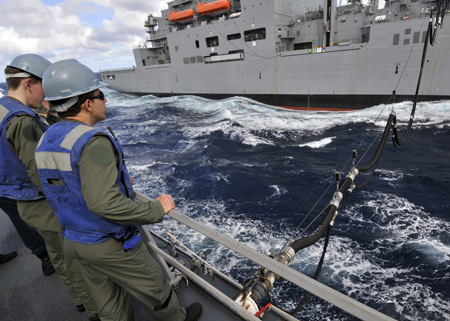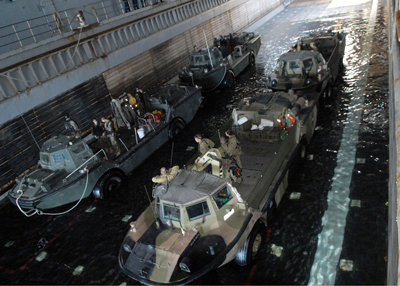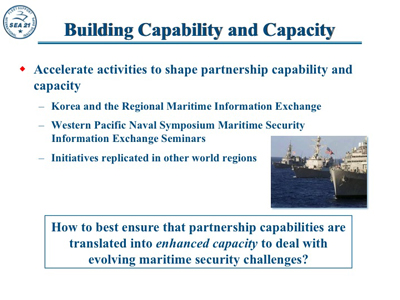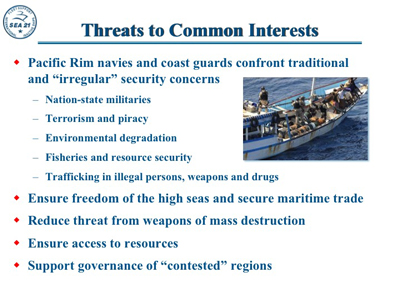SEA 21 And Facilitating Global Maritime Partnerships
By Rear Admiral James McManamon
Rear Admiral James McManamon is Deputy Commander Surface Warfare (SEA 21) of the Naval Sea Systems Command for the US Navy. In his current position, Rear Admiral James McManamon is concerned with shaping the capabilities of the US Navy and its allies to maintain ready fleets. In an era of tight budget, getting full capability of existing fleets and ensuring that new platforms are optimized for lifetime support is essential to effective defense capability in the 21st century. Effective naval partnerships must encompass the support and sustainable challenges facing US and allied fleets. In this posting, Rear Admiral McManamon addresses the challenge of building effective partnerships for sustainment with allies.
An interview with Rear Admiral McManamon was posted on our website a fewmonths ago and an overview of one of the key programs sponsored by his office for the FFG class of ships with global partners has been recently published by two contributors to the website, Scott Truver and Rob Holzer.
***

- PACIFIC OCEAN: Midshipmen from the Royal Australian Navy aboard the Arleigh Burke-class guided-missile destroyer USS Mustin (DDG 89) watch the Military Sealift Command dry cargo/ammunition ship USNS Amelia Earhart (T-AKE 6) deliver fuel during a refueling at sea. Mustin is participating in Talisman Saber 2009, a joint exercise between U.S. and the Australian Defense Force designed to train Australian and U.S. forces in planning and conducting combined operations. (U.S. Navy photo by Mass Communication Specialist 2nd Class Bryan Reckard/Released, July 8, 2009)
Meeting Pacific Rim Maritime Challenges
Distinguishing characteristics of Pacific Rim nations are their vast coastlines bordering immense ocean space, creating unique challenges to and opportunities for maritime security. For naval forces and maritime communities at large, this geographic reality creates mutual imperatives for all of the delegates at the Pacific 2010 International Maritime Conference.
Indeed, the key words are mutual and community, for none of the challenges confronting Pacific Rim states can be addressed adequately by one government alone, and no single Pacific Rim nation can fully embrace the tremendous opportunities afforded by proximity to the world’s largest ocean.
Senior naval and maritime leaders recognize these imperatives. For example, in his March 2009 U.S. Naval Institute Proceedings article, “The Commanders Respond,” Australia’s Chief of Navy, Vice Admiral R.H. Crane, noted, “Australia’s continued reliance on the maritime environment will dominate our thinking.” Vice Admiral Crane also outlined the major future acquisitions the Royal Australian Navy (RAN) will make in air-warfare destroyers (modeled on the U.S. Navy’s Arleigh Burke-class (DDG-51) Aegis destroyer) and amphibious assault ships that will help safeguard Australia’s maritime interests.[1]
U.S. Chief of Naval Operations Admiral Gary Roughead has underscored this focus on the maritime environment in his remarks at the 19th Biennial International Seapower Symposium in Newport, Rhode Island. In addressing the mutual interests in these unique challenges and opportunities to the delegates of the 100+ nations represented at the September 2009 event, he noted:
At this largest gathering of naval leaders in history, we here today represent our countries’ efforts not only to defend our respective maritime interests and our shores, but also to secure the global maritime commons at a time of great challenge. The stakes are massive: our activities – individually and in partnership – are vital to the future generations.[2]
The U.S. Navy has an enormous stake in supporting and sustaining Global Maritime Partnerships (GMP), and the Surface Warfare Directorate (SEA 21) for the U.S. Naval Sea Systems Command (NAVSEA), is the Navy’s principal agent for supporting our many coalition partners. We do this in numerous ways, principally by building both the capability to succeed in a multi-dimensional threat environment and the capacity to work together on the global commons.
The nations – as well as their navies, coast guards, and maritime industry partners – represented at the Pacific 2010 International Maritime Conference recognize the need to work together to address mutual threats to the global commons. From the SEA 21 perspective, this cooperation occurs both globally, under the auspices of the GMP, as well as regionally, in a growing number of maritime alliances, many led and sustained by governments represented at this conference.
SEA 21, as well as our national and international partners – including Australian’s Defence Material Organization – has a keen eye on what it takes to support the GMP with mission-capable ships. As our nations and navies band together to address threats to our mutual interests, we must recognize that at the end of the day we will need to ensure our warships continue to meet the missions for which they are designed over their expected service lives.
Threats to Mutual Interests
Clearly, the navies and coast guards of the Pacific Rim must work collectively to deal with security issues including terrorism and piracy, environmental violations, fisheries security and trafficking in illegal persons, weapons, or drugs. Indeed, navies and coast guards will be increasingly stressed to fulfill their myriad responsibilities while ensuring their ships and craft are well maintained and ready for tasking.
The need to work together to ensure continued economic prosperity and dissuade or defeat those who would use the oceans to do us harm is as critical now as it has ever been. Globalization has borne exponential growth in seaborne commerce, which has more than quadrupled in the past four decades. The tri-service U.S. maritime strategy, A Cooperative Strategy for 21st Century Seapower, put it in these terms:
The oceans connect the nations of the world, even those countries that are landlocked. Because the maritime domain – the world’s oceans, seas, bays, estuaries, islands, coastal areas, littorals, and the airspace above them – supports 90% of the world’s trade, it carries the lifeblood of a global system that links every country on earth. Covering three-quarters of the planet, the oceans make neighbours of people around the world. They enable us to help friends in need and to confront and defeat aggression far from our shores.[3]
A critical element of this cooperation and collaboration will be a “whole of governments” approach to Maritime Domain Awareness (MDA). At its foundation, MDA supports a broad spectrum of operations and is a global process to understand changes in the maritime domain, how these changes might affect our vital interests, and how best to respond across this broad spectrum of traditional and trans-national threats to the maritime, or “contested” commons – and, by extension, to our homelands.[4]
Ultimately, the ability of the RAN to ensure Australian security and prosperity in accordance with the recent Australian Defence White Paper Defending Australia in the Asia Pacific Century: Force 2030 will depend not just on the capability of that force, but on its capacity. In seeking this capacity, Australia – as well as all the nations of the Pacific Rim – must depend not only on newly purchased ships but also on the current ships, submarines and craft already in their inventories. And like the RAN, the navies and coast guards of the other nations represented at the Pacific 2010 conference must also get more life and nautical miles out of their in-service ships and craft.

- PACIFIC OCEAN (July 8, 2009) Midshipmen from the Royal Australian Navy aboard the Arleigh Burke-class guided-missile destroyer USS Mustin (DDG 89) watch the Military Sealift Command dry cargo/ammunition ship USNS Amelia Earhart (T-AKE 6) deliver fuel during a refueling at sea. Mustin is participating in Talisman Saber 2009, a joint exercise between U.S. and the Australian Defense Force designed to train Australian and U.S. forces in planning and conducting combined operations. (U.S. Navy photo by Mass Communication Specialist 2nd Class Bryan Reckard/Released)
Building Partnership Capability and Capacity
Today, globalization and the presence of a new generation of threats on the high seas, the littorals, and the near-shore land areas demand even closer cooperation among navies and coast guards everywhere. Defending Australia in the Asia Pacific Century: Force 2030 explained that Australia’s defense policy:
…entails the maintenance of alliances and international defence relationships that enhance our own security and allow us to work with others when we need to pool our resources…this defence policy means that we must have the capacity to lead military coalitions where we have shared strategic interests at stake with others…and make tailored contributions to military coalitions where we share wider strategic interests with others.[5]
This point of view is embraced by a growing number of nations, and commanders of many naval forces have become increasingly mindful of the centrality of partnership to the preservation of the safety and security of the world’s oceans. As the number of navies participating in these partnerships and their enthusiasm for this cooperation has grown, the results have been nothing short of stunning. Less than five years ago, about 70 navies and some 50 service chiefs attended the 17th Biennial International Seapower Symposium. By the 19th such symposium, more than 100 nations and 90 chiefs of service came together.
It is the actions these navies and coast guards are taking to work with their respective naval partners in other nations that are even more impressive. In addition to the partnering activities mentioned above, numerous navies and coast guards are taking the lead in partnering activities in their regions and are achieving real results.
- For example, Korea has stood up a Regional Maritime Information Exchange, and the Western Pacific Naval Symposium Maritime Security Information Exchange Seminars are helping to establish standard operating procedures for information sharing.
- In the Persian Gulf, more than 20 states attend the monthly Shared Awareness and De-confliction (SHADE) meetings in Bahrain, with the European Union, NATO, and maritime industry as active participants. The goal here is to develop and share unclassified common operating pictures and databases, and to synchronize combined maritime forces.
- In the Americas, navies have put in place the Inter-American Telecommunications Network, a secure, regional system for sharing information. The U.S. Southern Command has set up the Cooperating National Information Exchange System designed to improve maritime and air domain awareness by providing partner countries with real-time data on potential trafficking targets of interest.
- In the Mediterranean, Italy has taken the lead in establishing a Virtual-Regional Maritime Traffic Center supported by 29 navies and which has four separate sub-regional initiatives, including one with Lebanon and another with five North African littoral countries. In 2008, Italy also put in place a federated Trans-Regional Maritime Network –– yet another regional piece of the global maritime partnership solution.
Growing the capability and the capacity of naval and maritime power to prevail against the myriad threats is always challenging, but perhaps even more so today due to the worldwide economic downturn and the cost of new ships. That is why the U.S. Navy in general, and the Naval Sea Systems Command, in particular, are dedicated to ensuring that U.S. surface forces are ready for tasking in the most cost-effective manner, a dedication that extends to America’s global maritime partners, as well.

***Posted on March 22nd, 2010
Footnotes:
[1] Crane, R.H. (2009), “The Commander’s Respond,” U.S. Naval Institute Proceedings, March 2009.
[2] Roughead, G., (2009) Remarks at the 19th Biennial International Seapower Symposium, Newport, Rhode Island, October 17, 2009.
[3] ) Conway, J.T., Roughead, G., Allen, T.W. (2007) A Cooperative Strategy for 21st Century Seapower (Washington, D.C., Department of the Navy, 2007), pp. 1-16.
[4] Stubbs, Bruce B., (2009) Maritime Domain Awareness: Global Perspectives and Partnerships, Remarks at the Sixth Annual Coastal Surveillance Conference, Singapore, November 2009, www.dodeaformda.navy.mil.
[5] Defending Australia in the Asia Pacific Century: Force 2030 (2009) (Canberra, Australia, Australian Government Department of Defence, 2009), accessed at: www.defence.gov.au
———-
***Posted March 23rd, 2010


